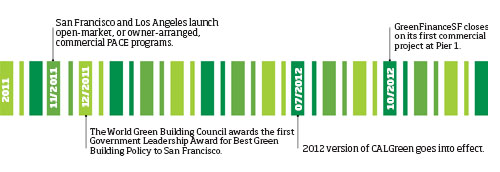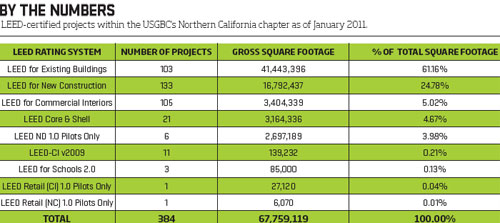California Greenin'
The solution was to shift from residential to commercial properties, because such real estate is not under FHFA’s purview. With the goal of creating a larger market with uniform documents and procedures, San Francisco worked in tandem with the city of Los Angeles for about a year to develop an open-market (or owner-arranged) commercial PACE program, which launched in both cities in November 2011.
 |
The commercial version is structured differently from the residential model. In this case, the city will help introduce property owners to qualified lenders, but it is up to the two private parties to negotiate project financing. If the city approves the final project, it will sell a bond to the participating lender, the proceeds from which will fund the retrofit. A special tax is then levied on the property, which is collected by the city and paid back to the lender. Operational costs are currently being covered by various grant funds, including money from ARRA. Once these are exhausted, owners will have to cover such fees, which could be rolled into the total financed amount.
Up to 100 percent of the hard and soft costs of the building-performance upgrade can be financed this way. Repayment can be passed through to a tenant’s lease, which avoids the so-called split-incentive problem in which a property owner cannot reap short-term benefits from an infrastructure upgrade that primarily rewards tenants by lowering lessees’ operating costs.
As with any special assessment, the lien will still be “senior” to the mortgage. Chien stresses that GFSF requires commercial owners to get approval from their current lender before obtaining PACE financing. He believes that, in doing so, mortgage lenders will become more knowledgeable about PACE, see how the financial mechanism can benefit the financial institution’s own long-term goals, allow them to potentially provide a new service or product to their customers (potentially as the PACE investor), and become increasingly interested in participating in such a program for any building type.
Although PACE’s path has been a little slow and circuitous, Chien believes in its long-term value: “The only way to scale up in terms of energy upgrades is to establish a way for those who provide capital—in other words, the banks—to see value. The challenge of reducing energy waste in our buildings is enormous, and PACE can attract the capital we need to do it.”
Los Angeles County’s open-market PACE program, which is almost identical to San Francisco’s, has received 12 applications, with many more in the works. This past September, Oakland-based Renewable Funding and the California Statewide Communities Development Authority launched CaliforniaFIRST—a new open-market PACE program now available to commercial-property owners in 14 counties and 126 cities in the state; it has already received 18 applications. And in October, GFSF closed on its first commercial project: a retrofit of Pier 1. Chien hopes that the knowledge his team has acquired on this first project will help it “demonstrate the process and benefits to other owners and lead the way to other commercial projects.”
 |
| Click on the image to view larger |








